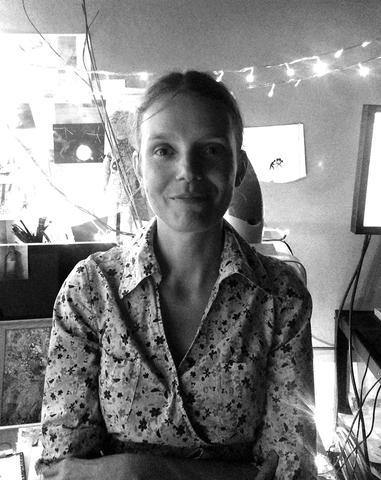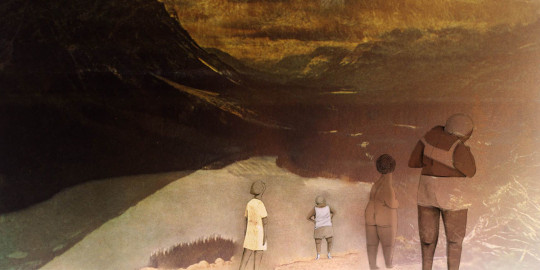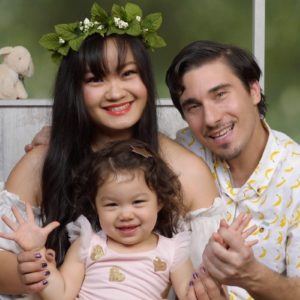Elise Simard is an animation director and homemade special effects expert with a style all her own. In the tradition of the avant-garde, her films don’t tell a single linear story; rather, they evoke the feelings of many stories, happening all at once, and all around us. Soon we’ll be able to experience her vision literally all around us, as she ventures into VR filmmaking. I hope you appreciate “Opening Hours” above, and her other films—“Breakfast” is the most introspective 2 minutes you’ll have all week. Elise has a wonderful ability to see the artistry in the ordinary, a knack that we can all aspire to. And beyond her talents, she’s a great person. Enjoy!

What can you tell us about ‘Opening Hours’?
It’s inspired by Jarry Park in Montreal; all the little lives that live and visit there. The park is big enough for many different energies to co-exist. It holds one of my favorite swimming pools in Montreal—I was inspired to explore what it’d be like if the pool had an occult, mysterious power. The goal was to open these different pockets of atmospheres, bringing people from one place to another without a traditional story.
Where did you study animation?
I went to Concordia University in Montreal to get a Bachelor’s of Fine Arts. I focused on design for two years, but fell in love with film animation, and began taking as many classes in it as I could. I was drawn into the animation program particularly because we were encouraged to be experimental. My first student film was even in 16mm!
Vintage! Why do you think animation was your calling?
I’ve always seen things from a cinematic angle, like viewing the world in shots and scenes. I’m excited by little things that inspire stories in me. At first, I was the atypical animation student in my class – I didn’t draw! It was only once I entered the program that I learned how to do so.
Whoa! So what’d you use to animate, before you had sweet drawing skills?
I used lots of cut-outs and raw materials – I still do! My first films, I drew on or around little pieces of tape and wood. I layered materials then photographed them, creating images just for the lens. And I played with how light draws out textures, which is still a focus in my work. With lighting, I can create a library of special effects, all self-generated.

What are some of your techniques?
There’s compositing, which lets me create my own computer graphics. And photographic compositing: exposing part of an image, covering it up, then exposing it again. Optical printing, as well. “Afloat at Dawn” demonstrates the effect of these techniques with lighting and texture. I shot on film for a long time before transitioning to digital.
What motivated that change from film to digital?
I grew curious about the potential of using new technologies to create. I actually just began a Master’s program for 3D animation a few months ago. I’m experimenting with VR especially. I’m still learning the basics, playing with the software and cameras.
That’s awesome. What do you imagine doing with VR?
I’m exploring its potential to create textures and luminous effects. I’m very excited about where it might go! I’m attracted to texture as a tool for storytelling, to evoke different emotional states. It’s difficult for me to describe exactly what I’m going for with VR… especially as I don’t yet know myself! It’s a new challenge.
Let’s talk motifs in your films, namely one: bears. What draws you to them?
Hmm, I’ve never really thought about that! They do show up quite a bit. I suppose because I prefer a subject barely moving at all, and very subtle movements. And I imagine bears as being very languid, so they inspire that kind of light motion for me. I suppose that’s why I’m drawn to them.
It’s funny, just yesterday I found the first thing that I ever animated in school: a bear walking! I’m doing tests on it in VR now, and it crackles, it’s so textured. It’s acetate, plastic, and the ink is 10 years old: chipped, yellowed, embedded with bits of dust. It’s a lovely discovery.
I love your ‘tiny musical’ “Breakfast”; what’s the story behind it?
I wrote the song in university. When I got the chance to spend two months at the Aberystwyth Arts Centre in Wales making a film, I had to choose a project very quickly. So I decided to record the song, with the lovely Clara Ortiz Marier singing. The film stemmed from the song. It was lightweight animation—everything I needed to create the film was in my suitcase.
Where does sound usually come into your process?
Sound is very important in my work. I usually start with sound, then fine tune it to what I see in my head. Process-wise, I’m drawn to technical challenges and using formal elements, like sound, to evoke feelings and moods. I try to be as intuitive as possible in the way that I sculpt story.
Your work is avant-garde; what are your thoughts on narratives?
I’m so bored when I’m locked into a narrative! I use it as a starting point. For example, “Beautiful Like Elsewhere” is a scifi film, written with a clear narrative. But in creating the film, I backed up—I wanted to evoke a sense that you are viewing this story from another dimension. A more lyrical, visceral experience. Part of that is editing from the gut, rather than editing to a script.
How did your fascination with lighting come about?
As a child I played with mirrors a lot. I loved seeing how light reflected off of them, and how it changed when I altered the angle or amount. I would sit with mirrors in dark closets, experimenting. My Grandma had crystals – a whole basket of them – and I’d shine light through them to reflect on the walls. I suppose it makes sense that I’ve become an artist now! Although for the longest time, I was considering paths deemed more ‘practical’.
Was your family skeptical when you chose to study art?
My mother actually told me to do it. I didn’t care for what I was pursuing, and one day she said to me, “You know, art is what you love to do. Not everything needs to be hard. Why don’t you study it?” I’m lucky; my family was always encouraging.
Do you have a favorite among your films?
My latest film is always my favorite. So right now, it’s “Beautiful Like Elsewhere”.

As part of the NFB, you collaborate with other filmmakers often. How is that experience?
Yes, I’ve worked for other artists a lot, and I’ve been very fortunate—everyone that I’ve worked with has been open to my ideas and creations. And they’ve opened up their processes to me. I’ve learned from everyone with whom I’ve collaborated.
Who are your biggest inspirations?
Lately, I’ve been inspired by the book Thought-Forms by Annie Besant and C.W. Leadbeater; it was created at the turn of the 20th century, and inspired the making of this magical bum. I’m very interested in transforming sex into lyrical and immersive forms right now, and this is part of a 3D experiment I’m currently undertaking.
I deeply admire Agnes Varda; her warmth, presence, and audacity are so inspiring. Even more so now that I am entering this new and wide open field of VR and emerging tech. There are qualities of her work that I’d love to see translated into VR. I’m not sure how it all relates yet, but I’m keeping an open mind.
Thank you for sharing your work with me Elise! Best of luck on all of your projects. I can’t wait to see where your VR ventures take you, and the medium as a whole. It’s good to know there are artists ensuring that it won’t just be “a toy” after all!
– Cooper
Array



